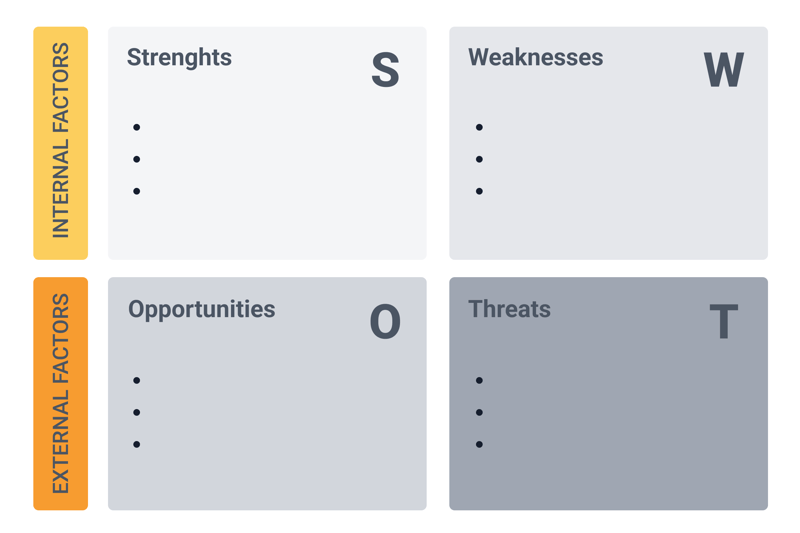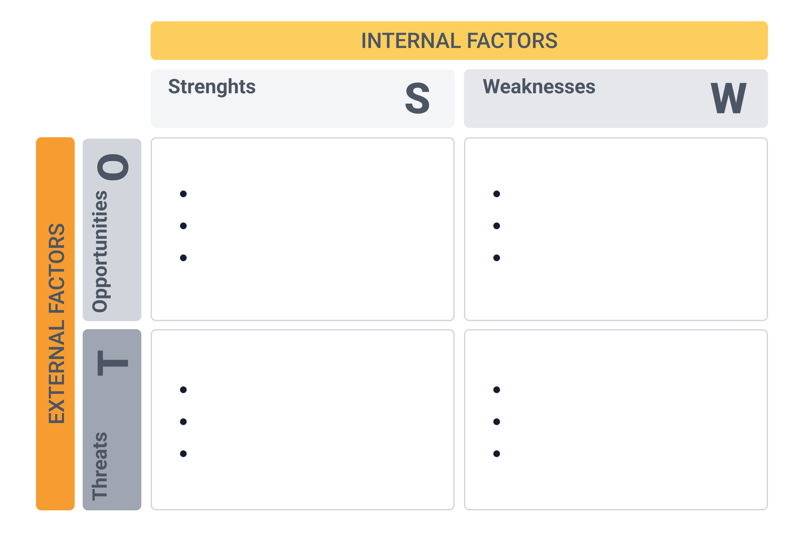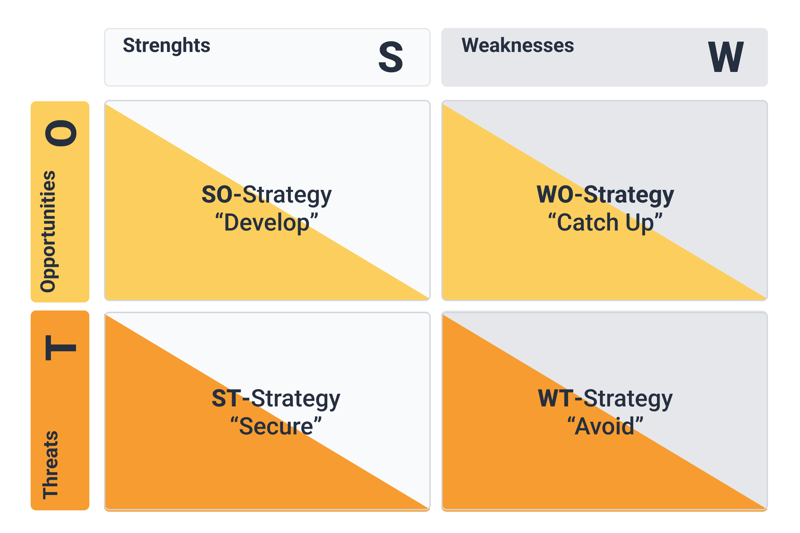The business world is growing faster and more competitive. Those who want to stay viable must be able to constantly react to the market's swiftly changing conditions and trends. It isn't just necessary to think, but to do so strategically, which is precisely what a SWOT analysis makes possible.
In this guide, we'll let you know what a SWOT analysis is, how you can do one, and how to use its findings to develop a successful strategy for your business.
What Is a SWOT Analysis?
A SWOT analysis helps businesses to strategically plan their development. It stands for:
Strengths
Weaknesses
Opportunities
Threats
Using this approach, you can identify internal strengths and weaknesses, as well as external opportunities and threats. Doing so allows you to better understand your business's position, as well as what steps need to be taken to reach your goals.
Elements of an SWOT Analysis: Strengths, Weaknesses, Opportunities, Threats
When producing an SWOT analysis, findings and information are arranged in a clear, 2x2 matrix:

The SWOT Analysis
Strengths
A business's strengths are generally internal characteristics that do not depend on external factors.
What are internal factors? These are those aspects of a business that a company is able to change on its own. Another way to think of strengths is as advantages that the business has, such as resources, capabilities, or financial means.
Examples of strengths include:
Qualified in-house experts and specialists
Stable processes
A corporate culture marked by flexibility and/or adaptability
Adequate financial means and resources
Weaknesses
Weaknesses are also internal and pertain to all of the disadvantages a particular business has in relation to its competitors. Think of these as the opposite of strengths.
Some examples include:
A lack of innovation
Low production capacity
Inadequate customer service
A shortage of qualified personnel
Opportunities
Opportunities are external factors that a business can make use of without being able to directly influence or control them. These broadly relate to market factors, events, or possibilities that if capitalized upon, would benefit the company.
Examples include:
Positive trends
New technology
Changes in customer needs
The exit of competitors from the market
Threats
Threats also cannot be directly influenced by the company. These include all potential risks, dangers, and disadvantages arising either from the market or competitors and should (as adequately as possible) be prepared for.
Examples of threats include:
Competitor innovations or increasing competition
New regulations or stricter laws
Increases in raw material and energy prices
Political crises
When Should I Use a SWOT Analysis?
It makes sense to perform a SWOT analysis whenever you want a snapshot of how your business is doing. Regular SWOT analyses are practical since they help to identify changes that might have an impact on your company. These can range from the appearance of a new competitor to the introduction of a new kind of technology or piece of software.
In addition to providing a broad overview of your business's status, a SWOT analysis can also be conducted within specific departments or sections. By doing so, you'll be able to more accurately estimate your chances of success as well as risks, helping you to make more informed decisions.
Here are a few examples of scenarios in which a SWOT analysis might prove useful:
Products and Services
Use a SWOT analysis to find out which of your new products or services might fare best on the market. You can also determine how your current offerings are doing, in order to develop them further, or make adjustments.Marketing
Evaluate customer behavior, competitors, and other relevant factors in order to develop an effective marketing strategy.Projects
Analyze the different factors that influence your project's success. In this way, you'll be able to take steps to reduce risk and ensure a more desirable outcome.Business founding
A SWOT analysis can help to evaluate your branch or target group, a new business location, or the best way to launch your brand.Process adjustments
Conducting a basic analysis can help to optimize your business's processes and improve performance.
As you can see, SWOT analyses are both useful and versatile. For that reason, many companies view them as an essential aspect of their business plans.
Create an SWOT Analysis in 4 Easy Steps
Doing a SWOT analysis is easier than you might think. Below, we'll describe the four easy steps in detail, while also explaining how you can develop a strategy based on your findings.
Create a Template and Specify Goal(s)
The first thing you'll need to do is to properly structure your SWOT analysis. As noted above, a SWOT analysis uses a 2x2 matrix consisting of 4 boxes. Since SWOT analyses always have the same format, it's a good idea to create a template or use an existing one.
After that, it's time to think about which area or aspect of your business you'd like to focus the analysis on. In this way, you'll ensure that your results are as pertinent and relevant to your needs as possible. Do you want to analyze all of your products and services at once, or perhaps, focus on one of them?
Depending on what expectations you have for your analysis, it can be a good idea to refine its scope.
Fill the SWOT Matrix
Now it's time to fill your matrix. Try to view each of the four factors from different perspectives. Keep in mind that the more forthcoming you are, the more meaningful your findings will be.
What to include? | Approach | Possible questions | |
|---|---|---|---|
Strengths | Evaluate your internal resources and capabilities, be sure to include those that set you apart from your competitors. | Internal business analysis |
|
Weaknesses | Critically and objectively assess internal processes and weaknesses. Do your best to identify competitive disadvantages. | Internal business analysis |
|
Opportunities | Analyze market and branch trends to identify potential growth opportunities. | External environment analysis |
|
Threats | Assess external factors that might challenge or threaten your business. | External environment analysis |
|
Once you've filled in all of the fields, your SWOT analysis is complete. Now, you can start to overcome your business's weaknesses and maximize its strengths.
However, there is another step you should take before embarking upon any concrete plan of action: Creating a TOWS matrix.
Create a Combined SWOT Matrix (TOWS Matrix)
A TOWS matrix helps to evaluate and interpret the results of your SWOT analysis. It combines the internal factors (strengths and weaknesses) with the external ones (opportunities and threats) in order to provide strategic options. For this reason, a TOWS matrix is also known as a "combined SWOT analysis".

TOWS matrix
Although the above looks like the SWOT analysis from the previous section, it's actually a TOWS matrix and is the go-to method for completing a SWOT analysis, combining both the first and second steps.
A basic SWOT analysis will show how your business is currently doing, however, a combined SWOT analysis goes one step further, by helping you to develop strategies for the future.
4 Strategies Based on a Combined SWOT Analysis
In order to create a TOWS matrix, you'll need to combine the findings from your SWOT analysis. There are four strategies for doing this:

A combined SWOT analysis offers users four strategic directions for further development.
1. SO Strategy: Develop – Combine Strengths and Opportunities
Use your business's strengths to take advantage of market opportunities. This calls for a certain amount of creativity and innovation since you'll need to rethink how to most effectively utilize your strengths to achieve success.
2. WO Strategy: Catch Up – Combine Weaknesses and Opportunities
Confront your business's weaknesses in order to pursue market opportunities. You'll improve your standing in relation to your competitors, and leverage your enhanced position to capitalize on existing opportunities.
3. ST Strategy: Secure – Combine Strengths and Risks
Shore up your business's position on the market by using your strengths to offset and minimize your weaknesses.
4. WT Strategy: Avoid – Combine Weaknesses and Risks
Sidestep risks by identifying and eliminating your weaknesses. By neutralizing your weaknesses, you'll reduce your exposure to threats.
Select a Strategy and Identify Appropriate Measures
Now it's time to consider which kind of strategy you would like to follow, or, to combine multiple approaches with one another. Whatever you decide to do, make sure that the steps you want to take can be both measured and defined and that your goals are clearly articulated. The SMART formula can help in doing this.
It's also a good idea to create a plan of action, set milestones, and regularly gauge how much progress you've made toward your goals.
Case Study: Doing a SWOT Analysis
We've discussed the theory behind SWOT, but how do things look in practice? Next, we'll illustrate how a SWOT analysis actually goes with a case study.
For this, we're going to use a fictional company called "Marketing Star". The advertising company has carved out a place for itself on the market and enjoys a good reputation, however, its competitors have recently been able to wrest control over some segments of the market.
Set Goals
The "Marketing Star" team wants to analyze its market position and brand recognition by doing an SWOT matrix.
Fill In the SWOT Matrix
The business has performed an internal assessment and identified the following strengths and weaknesses. Thanks to an environmental analysis, external opportunities and threats have also been identified.
Strengths | Weaknesses |
|---|---|
|
|
Opportunities | Threats |
|---|---|
|
|
Create a Combined SWOT Matrix
Based on the information in the SWOT analysis, the marketing agency's team gets to work making a TOWS matrix, combining the strengths and weaknesses with their business's opportunities and threats. After combining these individual factors, they have four strategic options:
Based on our example, the following actions are possible:
Strategy | Example |
|---|---|
SO Strategy |
|
WO Strategy |
|
ST Strategy |
|
WT Strategy |
|
Select a Strategy and Decide on Measures
"Marketing Star" can now select from these strategies and, depending on which it chooses, take concrete steps.
Should the team decide to use the SO strategy, they might start posting expert videos and guides on social media channels. However, improving relations with another agency, or any of the other measures can also be pursued.
Advantages and Disadvantages of SWOT Analysis
Like almost everything in life, SWOT analysis has both advantages and disadvantages:
Comprehensive overview
A SWOT analysis provides a comprehensive overview of external and internal factors that play a role in whatever it assesses, whether it's a project, a product, or a business.Easy to do
It isn't difficult to create a SWOT matrix, and the results are easy to understand.Data-driven decisions
Based on the results, you can make a well-founded decision and select a suitable strategy.Versatile
SWOT analyses can help optimize certain processes, further develop your business, or decide upon new products and services. The areas of application are nearly limitless.Agile and customizable
Regularly performing a SWOT analysis ensures that you'll be able to quickly react to market changes and capitalize on advantages for your business.Gain new ideas
When doing a SWOT analysis and brainstorming each of the four factors, you or your team might come across new ideas or innovations, or think of better ways to utilize existing resources.
Varying quality of results
Results can vary depending on who performs the analysis. This is because the criteria that are considered in the analysis are often subjective.No causal relationship
Since the matrix does not prioritize the relative importance of the factors that are input, or their causal relationship to one another, it isn't as meaningful as more intricate analytical methods.Over-simplified
Users often greatly oversimplify complicated situations, with the result that factors play only an abstract role in a business's actual operation.Incompleteness
Analysis and results are often incomplete since all information (such as that about competitors) is rarely available.
Tips & Tricks
Despite the disadvantages, SWOT analyses offer a valuable and helpful tool. Here are some tips to make the most of the method:
Set clear goals: Decide which area you want to analyze and how detailed you want your assessment to be. Would you like a bird's eye view or do you want to zoom in on a specific aspect? Set clear goals so that you'll get the results you want.
Gather useful information: Good information provides useful insights which can help you make effective decisions. Cast a wide net and don't be afraid to include market research, external studies, surveys, and other data.
Select a wide group of participants: Include anyone who can provide meaningful input for your matrix. This can include stakeholders, staff members, and managers from different departments. By involving a wide spectrum of individuals, you'll get more varied ideas, all the while ensuring greater objectivity.
Be creative: Try to perceive the situation from multiple viewpoints, especially if they differ from your own. This will enable you and your team to develop more innovative solutions. Brainstorming can be particularly helpful.
Repeat analyses: Don't just perform a SWOT analysis once and call it a day: In order to actually benefit your project or business, you'll want to perform them regularly.
Create a plan of action: Specify which measures should be taken, assign responsibility for them to your team, and set reasonable deadlines. This will carry the momentum of the SWOT plan into the actual implementation stage and bring you closer to your desired results.
Conclusion
A SWOT analysis is a powerful tool for determining a business's strengths, weaknesses, opportunities, and threats. Through identifying your core competencies, it can help you seize upon competitive advantages in your branch or market segment. At the same time, SWOT analyses might reveal new trends and opportunities.
Once you've completed your SWOT analysis, you can use a TOWS matrix to reach strategic decisions and implement effective measures. Be careful when evaluating the results and critically assess each action. In that way, your SWOT analysis will help to strategically guide your business toward success.
FAQs
A SWOT analysis is a method for determining a business's current status. Users can further refine the subject area and investigate both internal and external factors relating to strengths, weaknesses, opportunities, and threats.
Since it combines the four boxes of a SWOT analysis with one another in order to provide strategies, a TOWS matrix is also commonly referred to as a combined SWOT analysis. In practice, a TOWS matrix is often an inseparable part of a SWOT analysis.
A SWOT analysis has a variety of different applications. It can help in product or service development, business founding, creation of a marketing strategy, or process optimization.
The TOWS matrix, or combined SWOT analysis, offers four strategies:
- 1.
Using strengths to seize upon opportunities.
- 2.
Reducing weaknesses to take advantage of opportunities.
- 3.
Harnessing strengths to neutralize threats.
- 4.
Combatting weaknesses to minimize threats.






